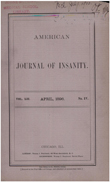Conduct disorder, substance use disorders, and coexisting conduct and substance use disorders in adolescent inpatients
Abstract
OBJECTIVE: The authors examined the association between conduct disorder and substance use disorders in adolescent inpatients. METHOD: Structured diagnostic interviews were given to 165 adolescent inpatients to assess the presence of DSM-III-R axis I disorders and personality disorders from axis II. Patients with conduct disorder (N = 25), substance use disorders (N = 24), and coexisting conduct and substance use disorders (N = 54) were compared to determine whether additional axis I and axis II disorders presented at significantly different rates. RESULTS: The groups with conduct disorder and coexisting conduct and substance use disorders had a higher proportion of male subjects than the group with substance use disorders alone. Patients with conduct disorder had an earlier age at first psychiatric contact and were diagnosed significantly more often with attention deficit hyperactivity disorder than the other two groups. Borderline personality disorder was diagnosed more frequently in the patients with substance use and coexisting conduct and substance use disorders than in the patients with conduct disorder. These differential co-occurrence patterns were observed for both male and female subjects. CONCLUSIONS: Conduct disorder and substance use disorders have high comorbidity rates with other psychiatric disorders in adolescent inpatients. The additional psychiatric comparison group (patients with coexisting conduct and substance use disorders) allowed for finer distinctions regarding psychiatric comorbidity. The validity of subtyping conduct disorder on the basis of the presence of a coexisting substance use disorder is suggested; conduct disorder patients without a coexisting substance use disorder are more likely to have attention deficit hyperactivity disorder.
Access content
To read the fulltext, please use one of the options below to sign in or purchase access.- Personal login
- Institutional Login
- Sign in via OpenAthens
- Register for access
-
Please login/register if you wish to pair your device and check access availability.
Not a subscriber?
PsychiatryOnline subscription options offer access to the DSM-5 library, books, journals, CME, and patient resources. This all-in-one virtual library provides psychiatrists and mental health professionals with key resources for diagnosis, treatment, research, and professional development.
Need more help? PsychiatryOnline Customer Service may be reached by emailing [email protected] or by calling 800-368-5777 (in the U.S.) or 703-907-7322 (outside the U.S.).



